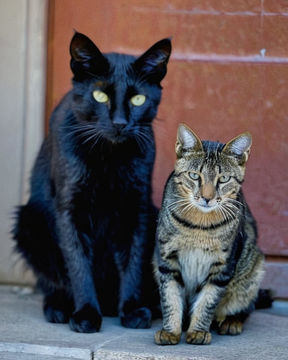Introduction: Cats, both feral and stray, have long been a part of urban and rural landscapes, often leading to debates and discussions about their welfare and impact on the environment. While the terms "feral" and "stray" are sometimes used interchangeably, there are distinct differences between these two populations of cats. Understanding these differences is crucial for implementing effective strategies to address their needs and mitigate potential issues. In this blog, we will delve into the characteristics, challenges, and implications of feral and stray cats, shedding light on the complexities of managing their populations.
Defining Feral and Stray Cats: Feral cats are those that have had little to no human interaction and are not socialized to people. They are typically born and raised in the wild or have reverted to a wild state after being abandoned. Feral cats are wary of humans and often live in colonies, scavenging for food and shelter in urban, suburban, or rural areas.
On the other hand, stray cats are animals that were previously owned or socialized to humans but have been lost or abandoned. Stray cats may exhibit varying degrees of socialization, and their ability to survive in the wild largely depends on their previous experiences and the length of time they have been without human care.
Challenges Faced by Feral and Stray Cats: Both feral and stray cats face numerous challenges that can impact their well-being and coexistence with humans and other animals. Feral cat populations, if left unmanaged, can contribute to concerns such as overpopulation, disease transmission, and predation on wildlife. Stray cats, especially those that are not spayed or neutered, may add to the existing population of free-roaming cats, leading to similar concerns.
Furthermore, both feral and stray cats may struggle to find reliable food sources and adequate shelter, exposing them to harsh environmental conditions and potential conflicts with humans. These challenges highlight the importance of responsible and humane management strategies for addressing the needs of feral and stray cat populations.
Implications for Communities and Ecosystems: The presence of feral and stray cats can have wide-ranging implications for communities and ecosystems. Uncontrolled feral cat populations may disrupt local wildlife, particularly bird populations, and can contribute to the spread of certain diseases. Stray cats, if not properly managed, may face risks such as traffic accidents, exposure to toxins, and conflicts with other animals.
Moreover, the welfare of these cats, whether feral or stray, is a matter of ethical and compassionate consideration. Finding a balance between addressing the needs of these animals and minimizing their impact on the environment requires a multifaceted approach that encompasses responsible pet ownership, community engagement, and targeted interventions.
Managing Feral and Stray Cat Populations: Efforts to manage feral and stray cat populations often involve a combination of strategies, including trap-neuter-return (TNR) programs, adoption initiatives for socialized stray cats, and community education on responsible pet ownership. TNR programs, in particular, have been recognized as an effective and humane method for stabilizing feral cat populations by preventing unchecked breeding and addressing public health concerns.
Community involvement and collaboration with animal welfare organizations are vital components of successful feral and stray cat management. By promoting spaying and neutering, providing resources for caretakers of feral cat colonies, and facilitating responsible rehoming of stray cats, communities can work towards creating more sustainable and harmonious environments for both human and feline inhabitants.
Conclusion: Feral and stray cats represent distinct populations with their own unique challenges and implications. Understanding the differences between these two groups is essential for implementing targeted and compassionate approaches to their management. By recognizing the complexities of feral and stray cat populations and embracing proactive and humane strategies, communities can strive to coexist with these animals while safeguarding the well-being of both the cats and the environment. Through education, outreach, and collaborative efforts, we can work towards fostering a more harmonious relationship between humans and free-roaming feline companions.

